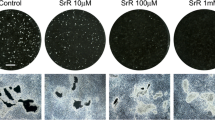Abstract
The effect of various flavonoids, which are present in food and plants, on bone calcium content and osteoclastogenesis were investigated to compare action of flavonoid on bone formation and bone resorption in vitro. Rat femoral-diaphyseal (cortical bone) and -metaphyseal (trabecular bone) tissues were cultured for 48 h in Dulbecco’s modified Eagle’s medium (high glucose) supplemented with antibiotics and bovine serum albumin. Amoung quercetin, myricetin, kaempferol, isorhamnetin, curcumin, hesperidin, or astaxanthin in the range of 10−7–10−5 M, culture with quercetin (10−6 or 10−5 M) caused a significant increase in diaphyseal calcium content. Such an effect was not seen in other compounds. Mouse bone marrow cells were cultured for 7 days in the presence of parathyroid hormone (PTH; 10−7 M), a bone-resorbing factor, in vitro. Culture with PTH caused a significant increase in osteoclast-like cell formation. This increase was significantly inhibited in the presence of quercetin, myricetin, kaempferol, isorhamnetin, or curcumin in the range of 10−8–10−6 M. Such an effect was not seen in the case of hesperidin or astaxanthin. In addition, culture with PTH (10−7 M) caused a significant decrease in diaphyseal calcium content. This decrease was completely prevented in the presence of quercetin, myricetin, kaempferal, or isorhamnetin of 10−6 M. This study demonstrates that various flavonoids have a potent inhibitory effect on osteoclastogenesis and bone resorption rather than bone formation in vitro. Among various flavonoids, quercetin had a stimulatory effect on bone formation and an inhibitory effect on bone resorption in vitro.






Similar content being viewed by others
References
Albright F, Smith PH, Richardson AM (1941) Postmenopausal osteoporosis: its clinical features. J Am Med Assoc 116:2465–2474
Riggs BL, Jowsey J, Kelly PJ, Jones JD, Maher FT (1969) Effect of sex hormones on bone in primary osteoporosis. J Clin Invest 48:1065–1072
Bonjour J-P, Schurch M-A, Ruzzoli R (1996) Nutritional aspects of hip fractures. Bone 18:139S–144S
Yamaguchi M (2002) Isoflavone and bone metabolism: Its cellular mechanism and preventive role in bone loss. J Health Sci 48:209–222
Yamaguchi M (2006) Regulatory mechanism of food factors in bone metabolism and prevention of osteoporosis. YAKUGAKU ZASSHI 126:1117–1137
Kimura M, Arai Y, Shimoi K, Watanabe S (1998) Japanese intake of flavonoids and isoflavonoids from foods. J Epidemiol 8:168–175
Horcajada-Molteni MN, Crespy V, Coxam V, Davicco MJ, Remesy C, Barlet JP (2001) Rutin inhibits ovariectomy-induced osteopenia in rats. J Bone Miner Res 15:2251–2258
Yamaguchi M, Oishi H, Suketa Y (1987) Stimulatory effect of zinc on bone formation in tissue culture. Biochem Pharmacol 36:4007–4012
Minkin C (1982) Bone acid phosphatase: tartrate-resistant acid phosphatase as a maker of osteoclast function. Calcif Tissue Int 34:285–290
Takahashi N, Yamada H, Yoshiki S, Roodman GD, Mundy GR, Jones SJ, Boyde A, Suda T (1998) Osteoclast-like cell formation and its regulation by osteotropic hormones in mouse bone marrow cultures. Endocrinology 122:1373–1382
Burstone MS (1958) Histochemical demonstration of acid phosphatase with naphthol AS-phosphate. J Natl Cancer Inst 21:523–539
Kim YJ, Bae YC, Suh KT, Jung JS (2006) Quercetin, a flavonoid, inhibits proliferation and increases osteogenic differentiation in human adipose stromal cells. Biochem Pharmacol 72:1268–1278
Son YO, Kook SH, Choi KC, Jang YS, Jeon YM, Kim JG, Lee KY, Kim J, Chung MS, Chung GH, Lee JC (2006) Quercetin, a bioflavonoid, accelerates TNF-alpha-induced growth inhibition and apoptosis in MC3T3-E1 osteoblastic cells. Eur J Pharmacol 529:24–32
Kuo PL (2005) Myricetin inhibits the induction of anti-Fas IgM-, tumor necrosis factor-alpha- and interleukin-1beta-mediated apoptosis by Fas pathway inhibition in human osteoblastic cell line MG-63. Life Sci 77:2964–2976
Wattel A, Kamel S, Prouillet C, Petit JP, Lorget F, Offord E, Brazier M (2004) Flavonoid quercetin decreases osteoclastic differentiation induced by RANKL via a mechanism involving NF kappa B and AP-1. J Cell Biochem 92:285–295
Wattel A, Kamel S, Mentaverri R, Lorget F, Prouillet C, Petit JP, Fardelonne P, Brazier M (2003) Potent inhibitory effect of naturally occurring flavonoids quercetin and kaempferol in vitro osteoclastic bone resorption. Biochem Pharmacol 65:35–42
Bharti AC, Takada Y, Aggarwal BB (2004) Curcumin (diferuloylmethane) inhibits receptor activator of NF-kappa B ligand-induced NF-kappa B activation in osteoclast precursors and suppress osteoclastogenesis. J Immunol 172:5940–5947
Kuiper GG, Lemmen JG, Carlsson B, Corton JC, Safe SH, van der Saag PT, van der Burg, Gustafsson JA (1998) Interaction of estrogenic chemicals and phytoestrogens with estrogen receptor beta. Endocrinology 139:4252–4263
Kano M, Takayanagi T, Harada K, Sawada S, IshikawaF (2006) Bioavailability of isoflavones after ingestion of soy beverages in healthy adults. J Nutr 136:2291–2296
Author information
Authors and Affiliations
Corresponding author
Rights and permissions
About this article
Cite this article
Yamaguchi, M., Hamamoto, R., Uchiyama, S. et al. Effects of flavonoid on calcium content in femoral tissue culture and parathyroid hormone-stimulated osteoclastogenesis in bone marrow culture in vitro. Mol Cell Biochem 303, 83–88 (2007). https://doi.org/10.1007/s11010-007-9458-x
Received:
Accepted:
Published:
Issue Date:
DOI: https://doi.org/10.1007/s11010-007-9458-x




